Owls, owls, everywhere
Influxes of magnificent birds have birders hurrying up north.
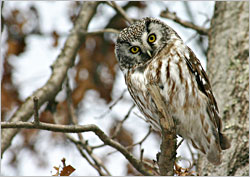
© Beth Gauper
In the north woods, irruptions of owls make birders ecstatic.
When food is scarce in far-north forests, owls fly south to look for it, many along the shores of Lake Superior.
I don't have the patience to look for birds. But when they come right to me . . . who can resist?
First it was the boreal owl in St. Croix State Park. We didn't realize how unusual it is to see an alert, curious boreal owl that far south and during the day — they're nocturnal — till we were hiking in Duluth and followed a stream of people to a red pine, where a balled-up boreal owl was sleeping on a high branch.
Birders from around the nation had gathered to see it, and they were thrilled. One man from Texas had called in sick to fly north and see it.
The next owl we saw was a great gray outside town. The birders had told us where to find it, and we assumed there would be a crowd surrounding it. But we were alone with the giant owl — at 2½ feet, North America's tallest — which watched us as intently as we watched it.
We've seen a lot of owls at the International Festival of Owls in the southeast Minnesota town of Houston. But seeing them in the wild is different.
We saw the little boreal owl in St. Croix State Park, 75 miles south of Duluth, only because a friend heard a tree creak and looked up. There it was, sitting on a low branch next to the trail, looking at us.
It was so close we could see its cream-and-caramel breast feathers rustling in the breeze. Occasionally, it blinked or swiveled its head in that creepy "Exorcist" style — owls have long and flexible necks and can turn their heads 270 degrees.
There were quite a few of us, and eventually, it flew away.
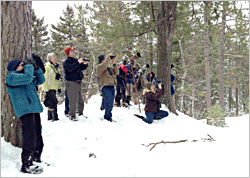
© Beth Gauper
I felt bad later, when I read that people need to be very quiet and keep a distance from these owls, who wouldn't be there if they weren't stressed and starving.
If an owl doesn't immediately fly away, it's not because it doesn't mind your presence. More likely, it's starving and exhausted, and fleeing from you depletes the energy it needs to hunt.
On our next accidental owl spotting, the following week, we were more interested in the birders than the bird.
We happened to be hiking on Tischer Creek in Duluth, just up from Glensheen, and we noticed a bunch of people tramping up the path alongside the creek. So we followed them.
A boreal owl had attracted two dozen people of all ages from all parts of the country, alerted to its presence by email or text message. Having just seen the St. Croix owl, we weren't that impressed by this one, which was sleeping and had tucked its head into its breast.
But the birders were.
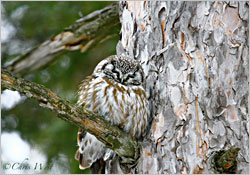
© Chris West
"They're ridiculously hard to find," one woman told us.
A Texas man had added it to his life list and said he had just nine more birds to go. We asked how he's able to get off work on such short notice, and he shrugged. "I just call and say, 'I don't feel well,' " he said.
Many of the birders were heading next to a church just up the North Shore, where a great gray owl had been spotted. A boreal owl hunts at night, but prime hunting hours for a great gray are late afternoon and early morning.
We decided to snowshoe part of the Superior Hiking Trail instead. The next morning, we skied in Lester Park, where we met two women from Minneapolis wandering around with binoculars.
"We drove around for 10 hours yesterday," one said. "We saw lots of birds, but no owls."
We told them where the boreal and great gray owls had been spotted. "Be careful, or you'll get addicted," they called as we walked away.
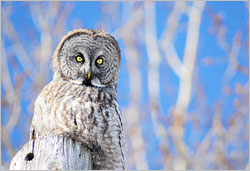
© Torsten Muller
It was high noon when we got to the North Shore Community Church, in a clearing off Old 61 east of town.
We saw a knob on top of a lamppost, some kind of finial we supposed, and we almost kept driving when we didn't see any other birders. Then the knob turned its head.
A great gray owl can hear a mouse when the mouse is buried under 18 inches of snow. This one definitely heard us crunching through the snow toward it, and it kept its piercing yellow eyes trained on us.
When we walked around the pole, it followed us; when we walked back, it craned its neck around the lamp to get a better view.
It was magnificent — so striking we concluded it couldn't possibly be the rare owl we'd heard about. It must be the more common barred owl, if only we were there to see it. Where was everybody?
After that, we drove farther along Old 61 to Stoney Point, where many owls had been reported. We saw birders — they're hard to miss, with their binoculars, tripods and huge camera lenses — but no birds.
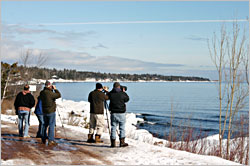
© Beth Gauper
We kept one eye on trees wherever we went, and on the drive back, we did see another great gray owl — but along the interstate, where we couldn't stop.
As soon as we got home, we joined the Owls About Minnesota Facebook group and started reading about all things owl.
We read Duluth ornithologist Laura Erickson's blog post about Why I Love Living in Northern Minnesota, which includes birding tips and a list of guides that can be hired.
We read posts on the blog of the North Shore's Sugarloaf Cove association about the owl irruption and the amazing great gray owl.
We watched Minnesota naturalist Sparky Stensaas' video about the boreal-owl irruption.
We watched a New York Times video that called owls "an avian tribe apart."
In the video, Norman Smith, director of the Audubon Blue Hills Trailside Museum in Milton, Mass., talks about a nesting pair of great horned owls he had watched.
"They brought in a pheasant, a number of ducks, a small raccoon, a woodchuck, two cats and a toy poodle," he said. "A lot of (chicks) don't survive, but if every great horned owl chick that hatched survived, there would be virtually nothing left in these woods."
Owls are fearsome predators, even the tiny saw-whet, which looks like a cuddly ball of fluff.
But if you're not a mouse or a vole, every sight of an owl is fascinating.
Trip Tips: Finding and watching owls
When to go: The irruptions of northern owls are cyclical, occurring when populations of small rodents crash.
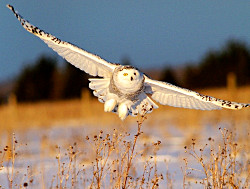
© Whitefish Point
Snowy owls thrilled birders when they irrupted from the Arctic in the winter of 2013-2014 and again in 2017-2018, when they began arriving in November and by December had gone as far south as Missouri.
Now, however, snowy owls are sighted every winter, possibly a sign of climate change: A greening Arctic leads to more rodents and then more snowies, not all of whom can stay in the breeding grounds.
In the winter of 2016-2017, an irruption of long-eared owls in the Chicago area caused a sensation.
In forests farther south, resident owls begin breeding in early March and often can be seen or heard.
Finding owls: Many birders report finds on the American Birding Association site, which can be searched by state or region and by bird sought.
Many local birding clubs send out alerts, including the Minnesota Ornithologists' Union, which also reports recently seen rare birds.
Audubon offers a great guide to finding and photographing owls.
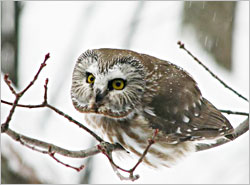
© Cable Natural History Mus
Near Duluth, the Sax-Zim Bog reports on recently seen birds.
In Duluth, birder Richard Hoeg reports on his frequent finds in his blog 365 Days of Birds.
Facebook groups, such as Owl About Minnesota, provide tips to members.
How to act around owls: Don't get too close, because you'll stress the bird. Never chase an owl from one place to another.
If you're in a car, turn off the engine. Owls hunt by ear, and engine noise may interfere with their search for food.
Here's a story from Outdoor Photographer about photographing owls with good field ethics.
Where to look: Many owls flying down from Canada are funneled down Minnesota's North Shore by the vast expanse of Lake Superior.
They often can be found in trees at the edge of clearings, where they watch for the small rodents they eat. Watch for crows mobbing a bigger bird; it's likely an owl.
Snowy owls can be spotted on the ground, often in snowy fields around schools and airports.
In northeast Minnesota, a good place to see a variety of owls is the Sax-Zim Bog, a sparsely populated area 45 miles northwest of Duluth off U.S. 53.
Great gray owls can be seen year-round, and boreal, snowy and northern hawk owls in winter.
The area is a mix of state forest, wildlife management areas and county and private land, with a variety of habitat in meadows, swamps, conifer bogs and woodlands. Many local residents put out feeders to attract birds and welcome human visitors.
Events: On the first weekend of March, the International Festival of Owls is held in Houston, Minn. Not far from the Mississippi in the southeast corner of the state, it features many kinds of live owls, plus evening owl prowls, owl-calling contests, pellet dissection and children's activities.
It also celebrates the hatch-day of Alice, the resident great horned owl at the Houston Nature Center.
For more, see Owl aboard.
Owl-banding at Whitefish Point Bird Observatory. On the east end of Lake Superior, near Sault Ste. Marie, Mich., naturalists band migrating owls from March 15 through May 31.
Late March is a good time see the northern saw-whet, the smallest owl. Others observed at the point include boreal, long-eared, short-eared, great horned, great gray and northern hawk owls.
On the last weekend of April, the observatory holds a Spring Fling birding festival that includes owl viewing at dusk and dawn.
It also bands owls July 1-Aug. 25 and during the fall migration, Sept. 15-Oct. 31.